Ethnographic Study: Social Settings and Behaviors in Sports Sector
VerifiedAdded on 2023/06/13
|9
|2085
|498
Essay
AI Summary
This essay presents an ethnographic study focusing on social norms and settings within the sports sector, using observation and interviews to understand different ethnic groups and their behaviors. The study employs Erving Goffman's dramaturgical theory to analyze how social settings influence individual actions and interactions. Data was collected through observations at a university sports event and semi-structured interviews with spectators from diverse ethnic backgrounds. The research identifies key themes such as the impact of social contextual norms on behavior, cultural practices, and the adaptation of norms in new social environments. Ethical considerations were prioritized throughout the data collection process. The study concludes that social settings and norms significantly shape individuals' lives, emphasizing the importance of ethnographic research in understanding societal behaviors and cultural dynamics. Desklib provides access to similar studies and resources.

1
Ethnography study in the sports sector
Student’s Name
Course
Professor’s Name
Institution’s Name
Institution’s Location
Date
Ethnography study in the sports sector
Student’s Name
Course
Professor’s Name
Institution’s Name
Institution’s Location
Date
Paraphrase This Document
Need a fresh take? Get an instant paraphrase of this document with our AI Paraphraser
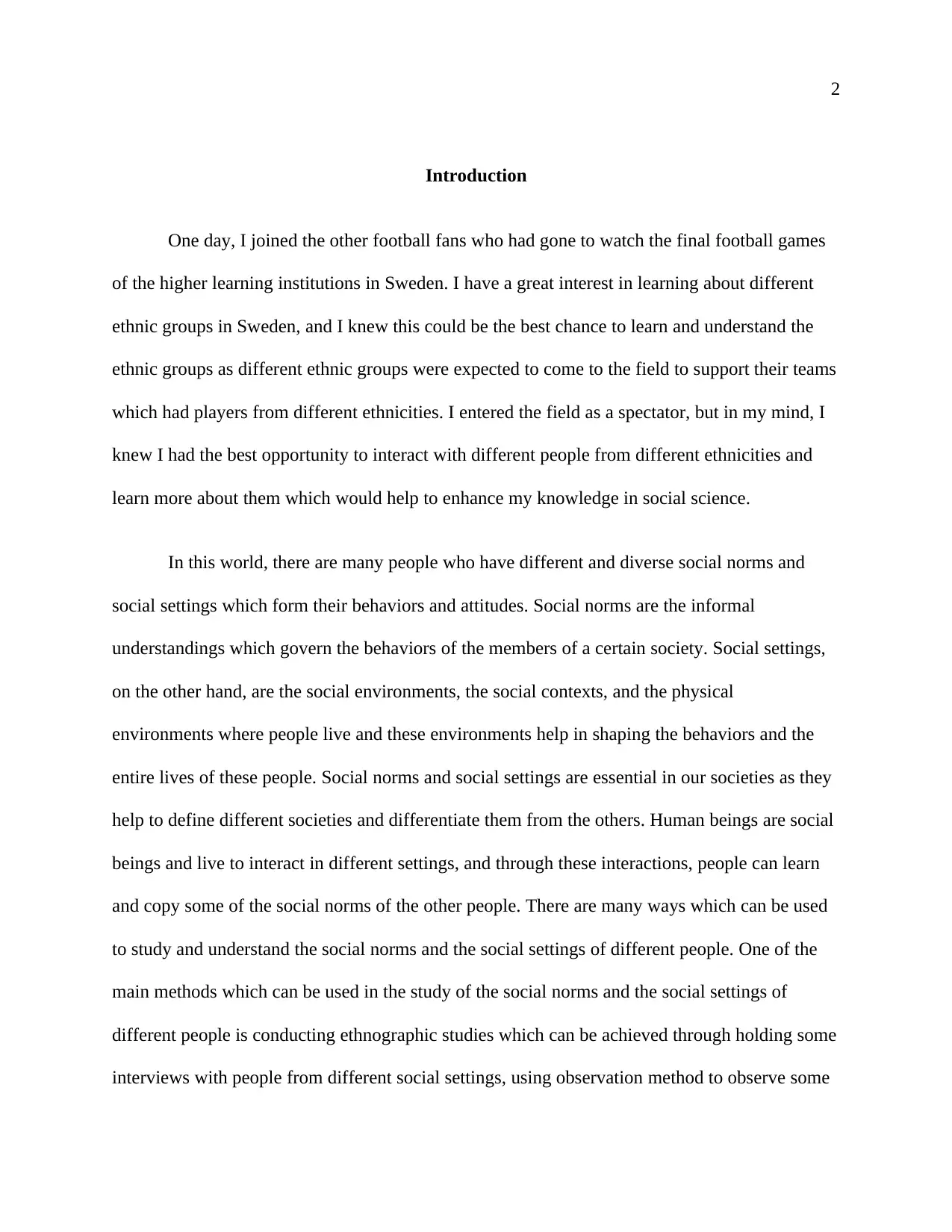
2
Introduction
One day, I joined the other football fans who had gone to watch the final football games
of the higher learning institutions in Sweden. I have a great interest in learning about different
ethnic groups in Sweden, and I knew this could be the best chance to learn and understand the
ethnic groups as different ethnic groups were expected to come to the field to support their teams
which had players from different ethnicities. I entered the field as a spectator, but in my mind, I
knew I had the best opportunity to interact with different people from different ethnicities and
learn more about them which would help to enhance my knowledge in social science.
In this world, there are many people who have different and diverse social norms and
social settings which form their behaviors and attitudes. Social norms are the informal
understandings which govern the behaviors of the members of a certain society. Social settings,
on the other hand, are the social environments, the social contexts, and the physical
environments where people live and these environments help in shaping the behaviors and the
entire lives of these people. Social norms and social settings are essential in our societies as they
help to define different societies and differentiate them from the others. Human beings are social
beings and live to interact in different settings, and through these interactions, people can learn
and copy some of the social norms of the other people. There are many ways which can be used
to study and understand the social norms and the social settings of different people. One of the
main methods which can be used in the study of the social norms and the social settings of
different people is conducting ethnographic studies which can be achieved through holding some
interviews with people from different social settings, using observation method to observe some
Introduction
One day, I joined the other football fans who had gone to watch the final football games
of the higher learning institutions in Sweden. I have a great interest in learning about different
ethnic groups in Sweden, and I knew this could be the best chance to learn and understand the
ethnic groups as different ethnic groups were expected to come to the field to support their teams
which had players from different ethnicities. I entered the field as a spectator, but in my mind, I
knew I had the best opportunity to interact with different people from different ethnicities and
learn more about them which would help to enhance my knowledge in social science.
In this world, there are many people who have different and diverse social norms and
social settings which form their behaviors and attitudes. Social norms are the informal
understandings which govern the behaviors of the members of a certain society. Social settings,
on the other hand, are the social environments, the social contexts, and the physical
environments where people live and these environments help in shaping the behaviors and the
entire lives of these people. Social norms and social settings are essential in our societies as they
help to define different societies and differentiate them from the others. Human beings are social
beings and live to interact in different settings, and through these interactions, people can learn
and copy some of the social norms of the other people. There are many ways which can be used
to study and understand the social norms and the social settings of different people. One of the
main methods which can be used in the study of the social norms and the social settings of
different people is conducting ethnographic studies which can be achieved through holding some
interviews with people from different social settings, using observation method to observe some
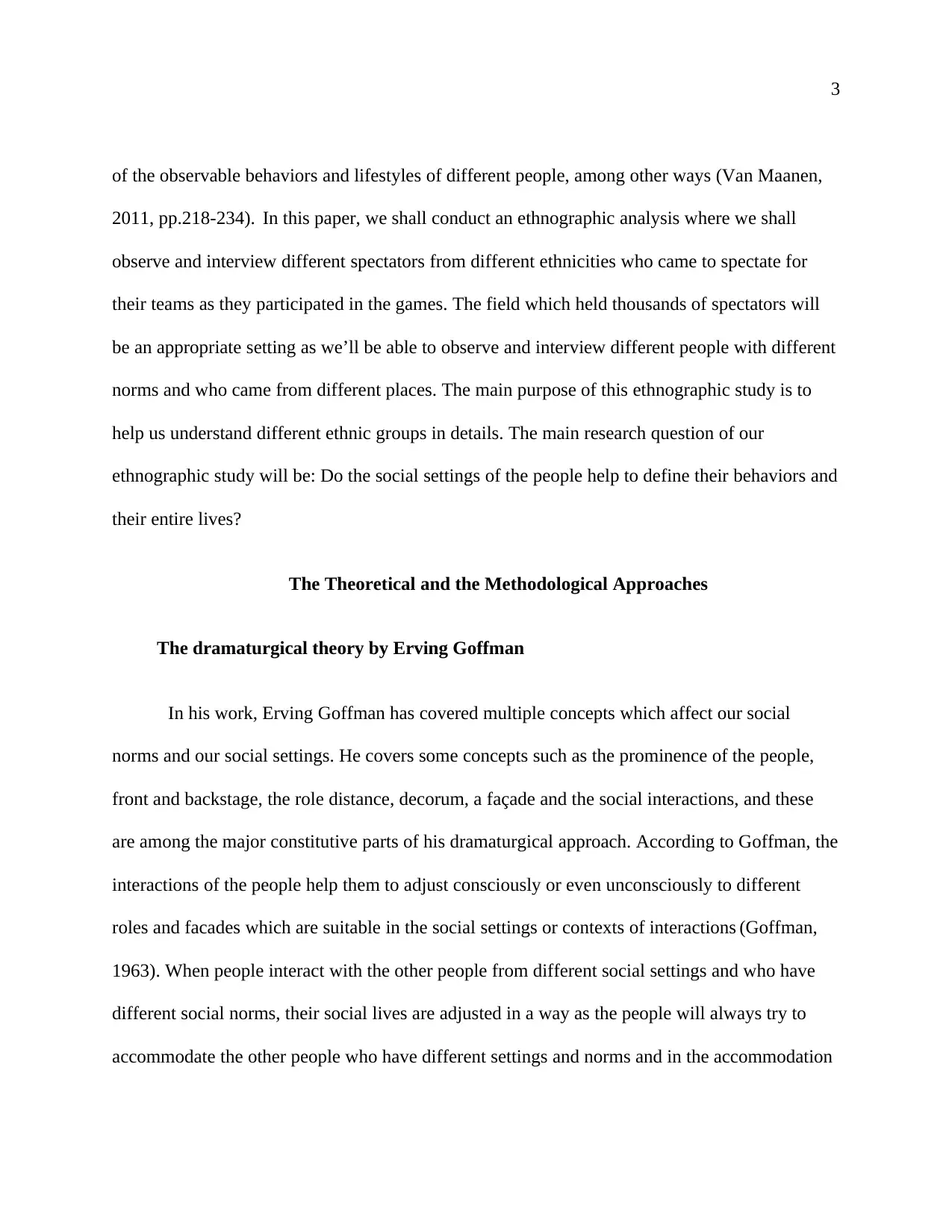
3
of the observable behaviors and lifestyles of different people, among other ways (Van Maanen,
2011, pp.218-234). In this paper, we shall conduct an ethnographic analysis where we shall
observe and interview different spectators from different ethnicities who came to spectate for
their teams as they participated in the games. The field which held thousands of spectators will
be an appropriate setting as we’ll be able to observe and interview different people with different
norms and who came from different places. The main purpose of this ethnographic study is to
help us understand different ethnic groups in details. The main research question of our
ethnographic study will be: Do the social settings of the people help to define their behaviors and
their entire lives?
The Theoretical and the Methodological Approaches
The dramaturgical theory by Erving Goffman
In his work, Erving Goffman has covered multiple concepts which affect our social
norms and our social settings. He covers some concepts such as the prominence of the people,
front and backstage, the role distance, decorum, a façade and the social interactions, and these
are among the major constitutive parts of his dramaturgical approach. According to Goffman, the
interactions of the people help them to adjust consciously or even unconsciously to different
roles and facades which are suitable in the social settings or contexts of interactions (Goffman,
1963). When people interact with the other people from different social settings and who have
different social norms, their social lives are adjusted in a way as the people will always try to
accommodate the other people who have different settings and norms and in the accommodation
of the observable behaviors and lifestyles of different people, among other ways (Van Maanen,
2011, pp.218-234). In this paper, we shall conduct an ethnographic analysis where we shall
observe and interview different spectators from different ethnicities who came to spectate for
their teams as they participated in the games. The field which held thousands of spectators will
be an appropriate setting as we’ll be able to observe and interview different people with different
norms and who came from different places. The main purpose of this ethnographic study is to
help us understand different ethnic groups in details. The main research question of our
ethnographic study will be: Do the social settings of the people help to define their behaviors and
their entire lives?
The Theoretical and the Methodological Approaches
The dramaturgical theory by Erving Goffman
In his work, Erving Goffman has covered multiple concepts which affect our social
norms and our social settings. He covers some concepts such as the prominence of the people,
front and backstage, the role distance, decorum, a façade and the social interactions, and these
are among the major constitutive parts of his dramaturgical approach. According to Goffman, the
interactions of the people help them to adjust consciously or even unconsciously to different
roles and facades which are suitable in the social settings or contexts of interactions (Goffman,
1963). When people interact with the other people from different social settings and who have
different social norms, their social lives are adjusted in a way as the people will always try to
accommodate the other people who have different settings and norms and in the accommodation
⊘ This is a preview!⊘
Do you want full access?
Subscribe today to unlock all pages.

Trusted by 1+ million students worldwide
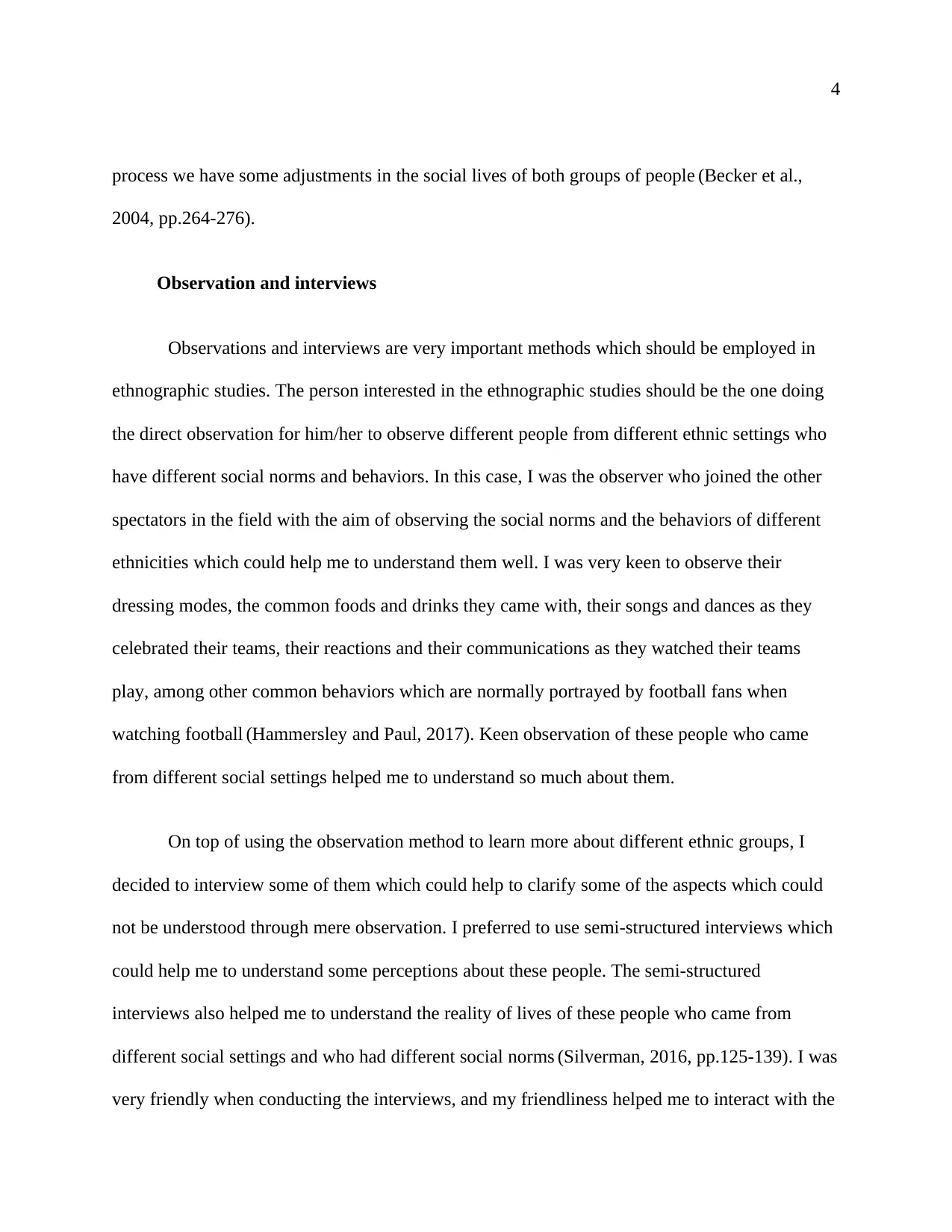
4
process we have some adjustments in the social lives of both groups of people (Becker et al.,
2004, pp.264-276).
Observation and interviews
Observations and interviews are very important methods which should be employed in
ethnographic studies. The person interested in the ethnographic studies should be the one doing
the direct observation for him/her to observe different people from different ethnic settings who
have different social norms and behaviors. In this case, I was the observer who joined the other
spectators in the field with the aim of observing the social norms and the behaviors of different
ethnicities which could help me to understand them well. I was very keen to observe their
dressing modes, the common foods and drinks they came with, their songs and dances as they
celebrated their teams, their reactions and their communications as they watched their teams
play, among other common behaviors which are normally portrayed by football fans when
watching football (Hammersley and Paul, 2017). Keen observation of these people who came
from different social settings helped me to understand so much about them.
On top of using the observation method to learn more about different ethnic groups, I
decided to interview some of them which could help to clarify some of the aspects which could
not be understood through mere observation. I preferred to use semi-structured interviews which
could help me to understand some perceptions about these people. The semi-structured
interviews also helped me to understand the reality of lives of these people who came from
different social settings and who had different social norms (Silverman, 2016, pp.125-139). I was
very friendly when conducting the interviews, and my friendliness helped me to interact with the
process we have some adjustments in the social lives of both groups of people (Becker et al.,
2004, pp.264-276).
Observation and interviews
Observations and interviews are very important methods which should be employed in
ethnographic studies. The person interested in the ethnographic studies should be the one doing
the direct observation for him/her to observe different people from different ethnic settings who
have different social norms and behaviors. In this case, I was the observer who joined the other
spectators in the field with the aim of observing the social norms and the behaviors of different
ethnicities which could help me to understand them well. I was very keen to observe their
dressing modes, the common foods and drinks they came with, their songs and dances as they
celebrated their teams, their reactions and their communications as they watched their teams
play, among other common behaviors which are normally portrayed by football fans when
watching football (Hammersley and Paul, 2017). Keen observation of these people who came
from different social settings helped me to understand so much about them.
On top of using the observation method to learn more about different ethnic groups, I
decided to interview some of them which could help to clarify some of the aspects which could
not be understood through mere observation. I preferred to use semi-structured interviews which
could help me to understand some perceptions about these people. The semi-structured
interviews also helped me to understand the reality of lives of these people who came from
different social settings and who had different social norms (Silverman, 2016, pp.125-139). I was
very friendly when conducting the interviews, and my friendliness helped me to interact with the
Paraphrase This Document
Need a fresh take? Get an instant paraphrase of this document with our AI Paraphraser

5
respondents well, and we shared some of their life ideas and experiences freely which made the
interviews very successful (DeVault and Liza, 2003).
The ethical considerations and dilemmas
Before collection of any data for whatever reason, it’s always important to consider ethics
which govern the people and respect all the rights of the people to make sure the data collection
process won’t cause any harm or discomfort to the respondents. In my case, to make sure I
observed ethics and respected all the rights of all the people who participated in the research, I
made sure I introduced myself fully to the participants and explained to them the reasons I was
collecting the data. I also made sure to remain very friendly and open to each of the respondents
and was ready to answer every question which could be asked by each of the respondents. I also
made sure I followed all the ethical principles and claims stipulated by the Swedish Research
Council to make sure I couldn’t cause any harm or discomfort to any of my respondents (The
Ministry of Education and Cultural Affairs, 2003).
There were some dilemmas which I encountered in my ethnography studies. Some of the
dilemmas which I faced include, should I have approved permission before collecting the data of
the respondents? What can happen to me if am caught collecting the data of the people without
the approval of the Swedish Research Council? How should I deal with the people who refuse to
participate in my data collection process? These are just a few of the many dilemmas which
faced me when I was collecting the data of different spectators (respondents) in the field (Lamont
and Ann, 2014).
respondents well, and we shared some of their life ideas and experiences freely which made the
interviews very successful (DeVault and Liza, 2003).
The ethical considerations and dilemmas
Before collection of any data for whatever reason, it’s always important to consider ethics
which govern the people and respect all the rights of the people to make sure the data collection
process won’t cause any harm or discomfort to the respondents. In my case, to make sure I
observed ethics and respected all the rights of all the people who participated in the research, I
made sure I introduced myself fully to the participants and explained to them the reasons I was
collecting the data. I also made sure to remain very friendly and open to each of the respondents
and was ready to answer every question which could be asked by each of the respondents. I also
made sure I followed all the ethical principles and claims stipulated by the Swedish Research
Council to make sure I couldn’t cause any harm or discomfort to any of my respondents (The
Ministry of Education and Cultural Affairs, 2003).
There were some dilemmas which I encountered in my ethnography studies. Some of the
dilemmas which I faced include, should I have approved permission before collecting the data of
the respondents? What can happen to me if am caught collecting the data of the people without
the approval of the Swedish Research Council? How should I deal with the people who refuse to
participate in my data collection process? These are just a few of the many dilemmas which
faced me when I was collecting the data of different spectators (respondents) in the field (Lamont
and Ann, 2014).
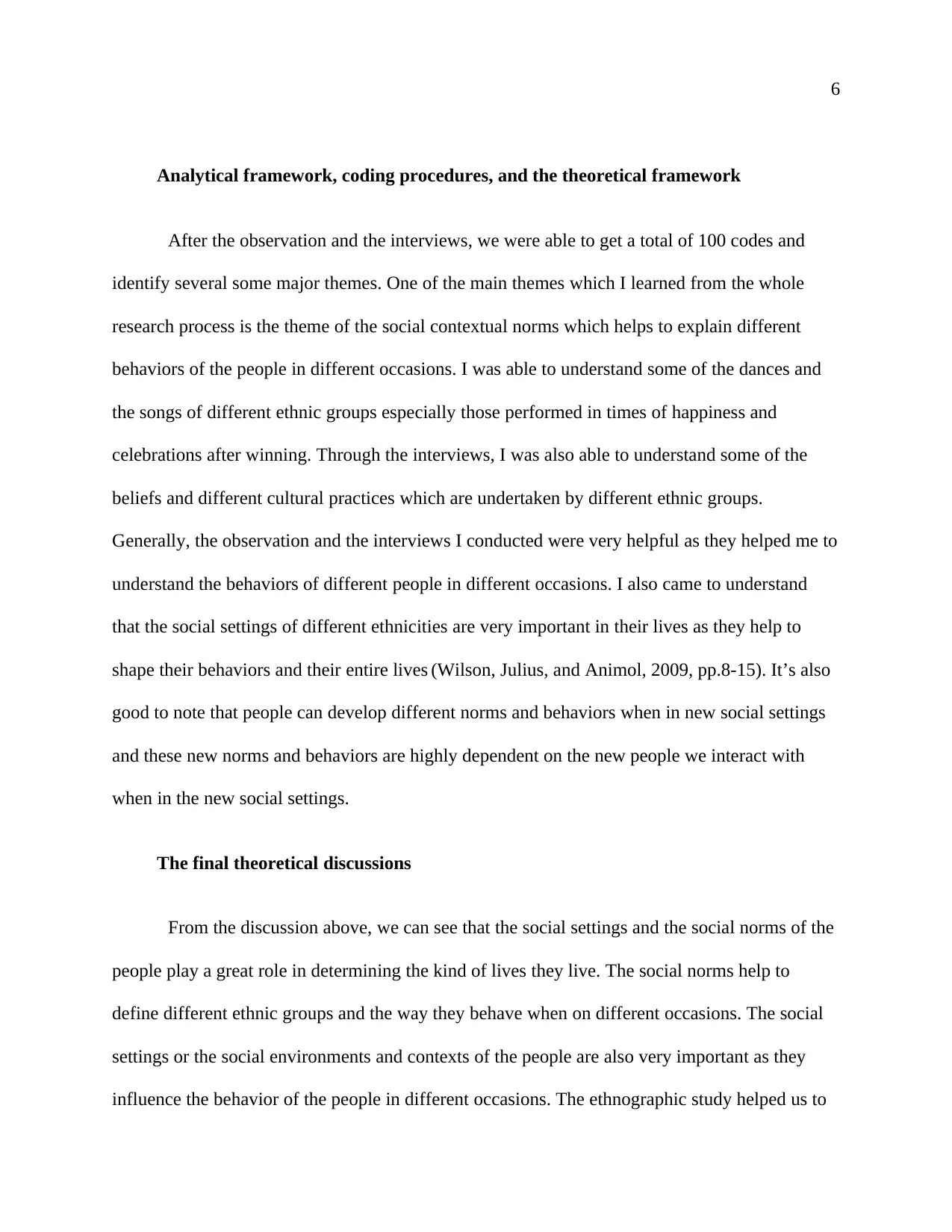
6
Analytical framework, coding procedures, and the theoretical framework
After the observation and the interviews, we were able to get a total of 100 codes and
identify several some major themes. One of the main themes which I learned from the whole
research process is the theme of the social contextual norms which helps to explain different
behaviors of the people in different occasions. I was able to understand some of the dances and
the songs of different ethnic groups especially those performed in times of happiness and
celebrations after winning. Through the interviews, I was also able to understand some of the
beliefs and different cultural practices which are undertaken by different ethnic groups.
Generally, the observation and the interviews I conducted were very helpful as they helped me to
understand the behaviors of different people in different occasions. I also came to understand
that the social settings of different ethnicities are very important in their lives as they help to
shape their behaviors and their entire lives (Wilson, Julius, and Animol, 2009, pp.8-15). It’s also
good to note that people can develop different norms and behaviors when in new social settings
and these new norms and behaviors are highly dependent on the new people we interact with
when in the new social settings.
The final theoretical discussions
From the discussion above, we can see that the social settings and the social norms of the
people play a great role in determining the kind of lives they live. The social norms help to
define different ethnic groups and the way they behave when on different occasions. The social
settings or the social environments and contexts of the people are also very important as they
influence the behavior of the people in different occasions. The ethnographic study helped us to
Analytical framework, coding procedures, and the theoretical framework
After the observation and the interviews, we were able to get a total of 100 codes and
identify several some major themes. One of the main themes which I learned from the whole
research process is the theme of the social contextual norms which helps to explain different
behaviors of the people in different occasions. I was able to understand some of the dances and
the songs of different ethnic groups especially those performed in times of happiness and
celebrations after winning. Through the interviews, I was also able to understand some of the
beliefs and different cultural practices which are undertaken by different ethnic groups.
Generally, the observation and the interviews I conducted were very helpful as they helped me to
understand the behaviors of different people in different occasions. I also came to understand
that the social settings of different ethnicities are very important in their lives as they help to
shape their behaviors and their entire lives (Wilson, Julius, and Animol, 2009, pp.8-15). It’s also
good to note that people can develop different norms and behaviors when in new social settings
and these new norms and behaviors are highly dependent on the new people we interact with
when in the new social settings.
The final theoretical discussions
From the discussion above, we can see that the social settings and the social norms of the
people play a great role in determining the kind of lives they live. The social norms help to
define different ethnic groups and the way they behave when on different occasions. The social
settings or the social environments and contexts of the people are also very important as they
influence the behavior of the people in different occasions. The ethnographic study helped us to
⊘ This is a preview!⊘
Do you want full access?
Subscribe today to unlock all pages.

Trusted by 1+ million students worldwide
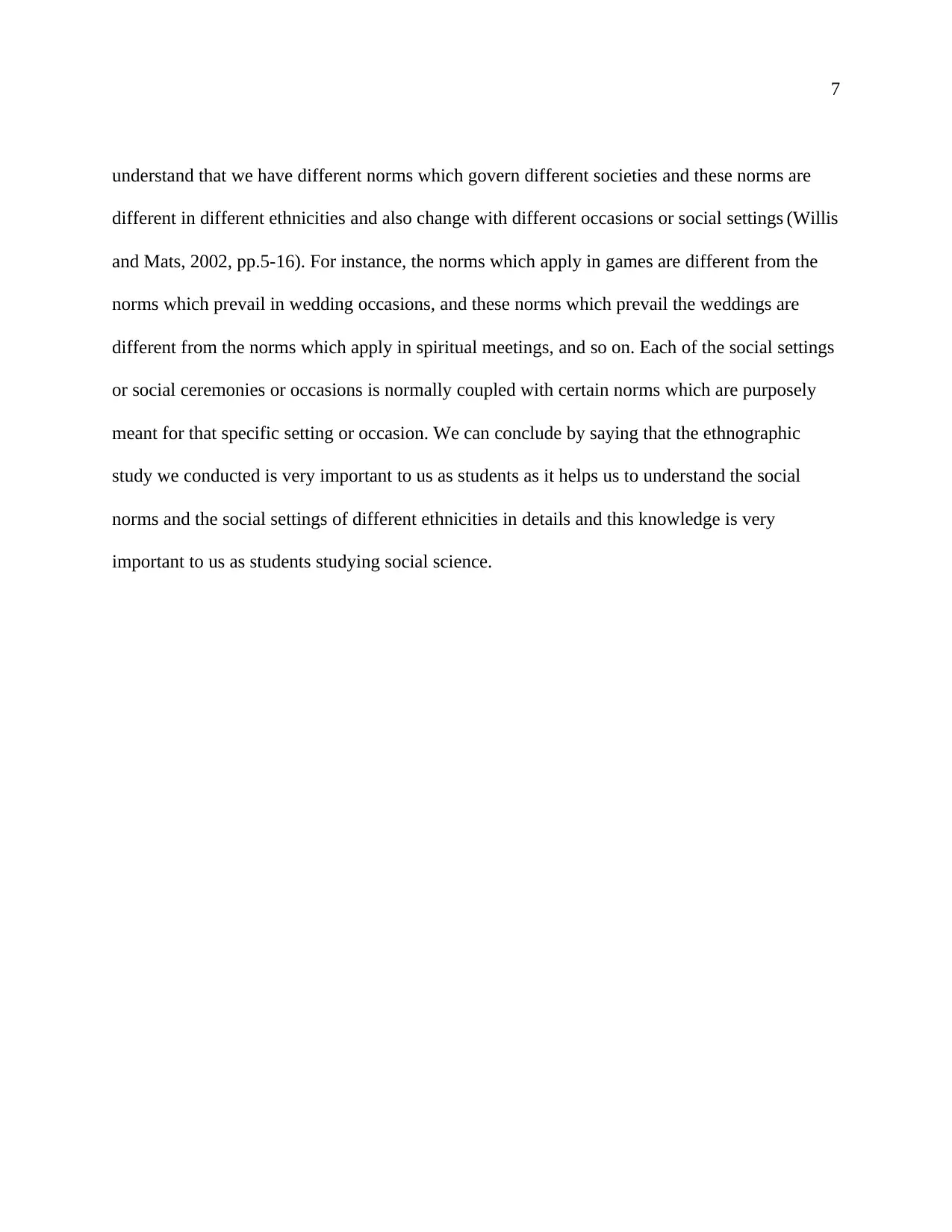
7
understand that we have different norms which govern different societies and these norms are
different in different ethnicities and also change with different occasions or social settings (Willis
and Mats, 2002, pp.5-16). For instance, the norms which apply in games are different from the
norms which prevail in wedding occasions, and these norms which prevail the weddings are
different from the norms which apply in spiritual meetings, and so on. Each of the social settings
or social ceremonies or occasions is normally coupled with certain norms which are purposely
meant for that specific setting or occasion. We can conclude by saying that the ethnographic
study we conducted is very important to us as students as it helps us to understand the social
norms and the social settings of different ethnicities in details and this knowledge is very
important to us as students studying social science.
understand that we have different norms which govern different societies and these norms are
different in different ethnicities and also change with different occasions or social settings (Willis
and Mats, 2002, pp.5-16). For instance, the norms which apply in games are different from the
norms which prevail in wedding occasions, and these norms which prevail the weddings are
different from the norms which apply in spiritual meetings, and so on. Each of the social settings
or social ceremonies or occasions is normally coupled with certain norms which are purposely
meant for that specific setting or occasion. We can conclude by saying that the ethnographic
study we conducted is very important to us as students as it helps us to understand the social
norms and the social settings of different ethnicities in details and this knowledge is very
important to us as students studying social science.
Paraphrase This Document
Need a fresh take? Get an instant paraphrase of this document with our AI Paraphraser
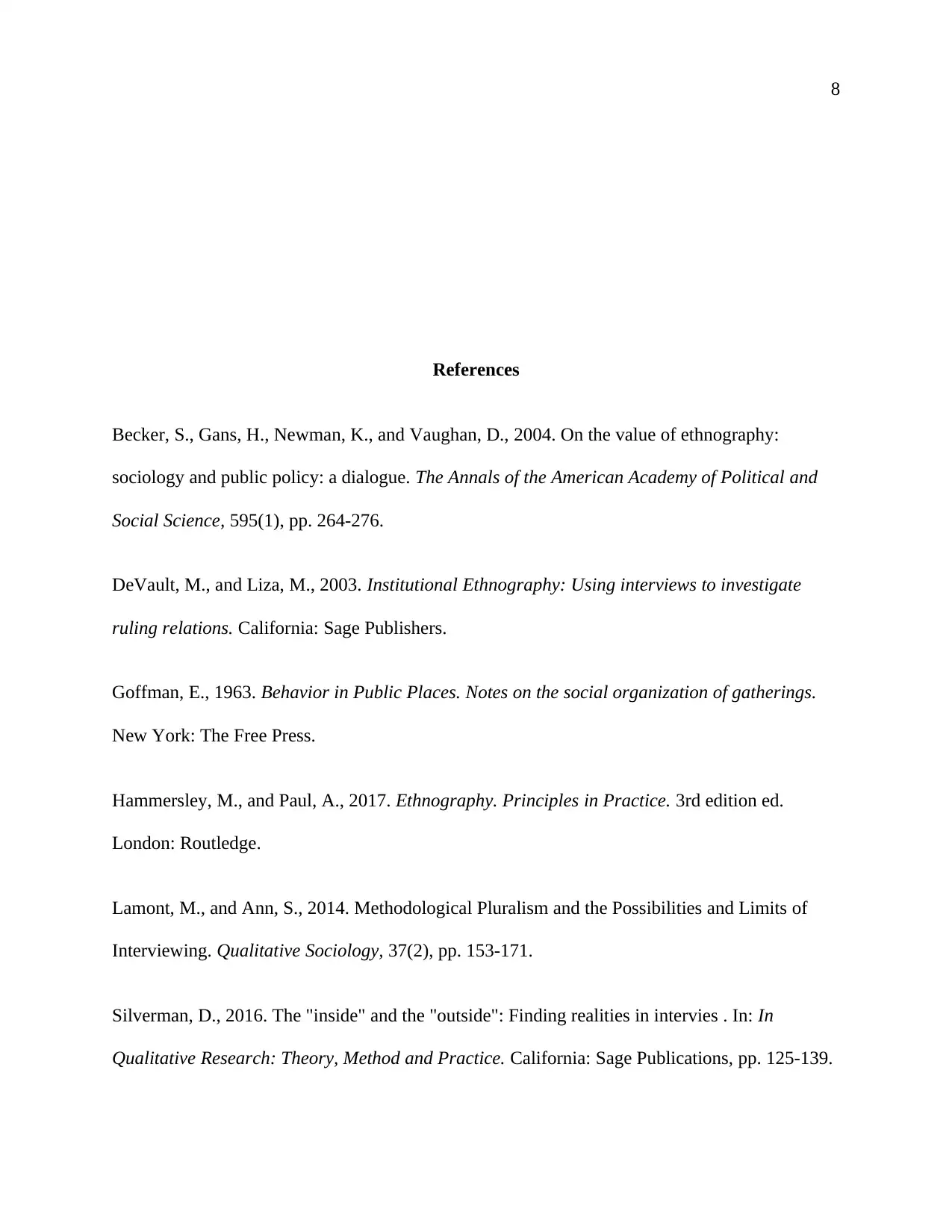
8
References
Becker, S., Gans, H., Newman, K., and Vaughan, D., 2004. On the value of ethnography:
sociology and public policy: a dialogue. The Annals of the American Academy of Political and
Social Science, 595(1), pp. 264-276.
DeVault, M., and Liza, M., 2003. Institutional Ethnography: Using interviews to investigate
ruling relations. California: Sage Publishers.
Goffman, E., 1963. Behavior in Public Places. Notes on the social organization of gatherings.
New York: The Free Press.
Hammersley, M., and Paul, A., 2017. Ethnography. Principles in Practice. 3rd edition ed.
London: Routledge.
Lamont, M., and Ann, S., 2014. Methodological Pluralism and the Possibilities and Limits of
Interviewing. Qualitative Sociology, 37(2), pp. 153-171.
Silverman, D., 2016. The "inside" and the "outside": Finding realities in intervies . In: In
Qualitative Research: Theory, Method and Practice. California: Sage Publications, pp. 125-139.
References
Becker, S., Gans, H., Newman, K., and Vaughan, D., 2004. On the value of ethnography:
sociology and public policy: a dialogue. The Annals of the American Academy of Political and
Social Science, 595(1), pp. 264-276.
DeVault, M., and Liza, M., 2003. Institutional Ethnography: Using interviews to investigate
ruling relations. California: Sage Publishers.
Goffman, E., 1963. Behavior in Public Places. Notes on the social organization of gatherings.
New York: The Free Press.
Hammersley, M., and Paul, A., 2017. Ethnography. Principles in Practice. 3rd edition ed.
London: Routledge.
Lamont, M., and Ann, S., 2014. Methodological Pluralism and the Possibilities and Limits of
Interviewing. Qualitative Sociology, 37(2), pp. 153-171.
Silverman, D., 2016. The "inside" and the "outside": Finding realities in intervies . In: In
Qualitative Research: Theory, Method and Practice. California: Sage Publications, pp. 125-139.
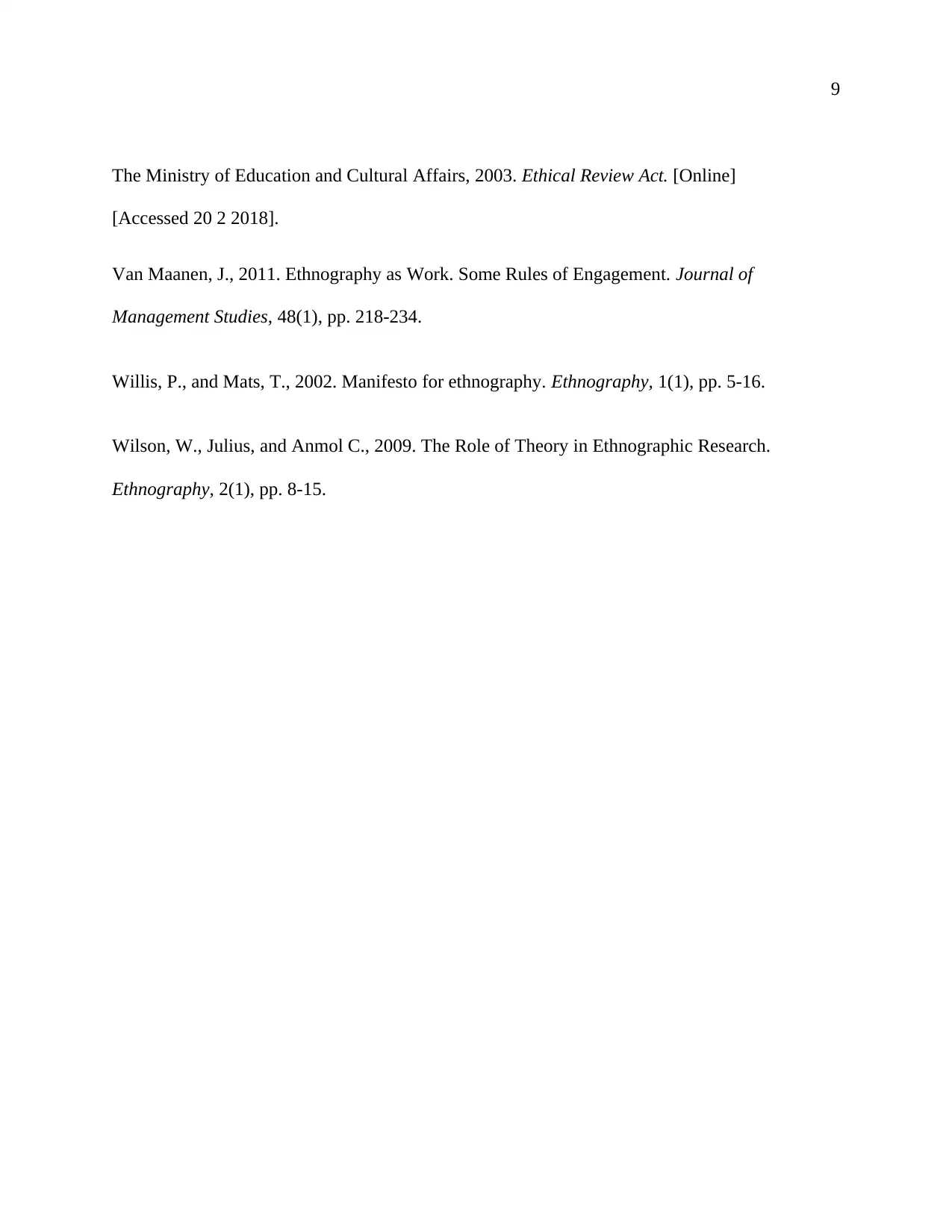
9
The Ministry of Education and Cultural Affairs, 2003. Ethical Review Act. [Online]
[Accessed 20 2 2018].
Van Maanen, J., 2011. Ethnography as Work. Some Rules of Engagement. Journal of
Management Studies, 48(1), pp. 218-234.
Willis, P., and Mats, T., 2002. Manifesto for ethnography. Ethnography, 1(1), pp. 5-16.
Wilson, W., Julius, and Anmol C., 2009. The Role of Theory in Ethnographic Research.
Ethnography, 2(1), pp. 8-15.
The Ministry of Education and Cultural Affairs, 2003. Ethical Review Act. [Online]
[Accessed 20 2 2018].
Van Maanen, J., 2011. Ethnography as Work. Some Rules of Engagement. Journal of
Management Studies, 48(1), pp. 218-234.
Willis, P., and Mats, T., 2002. Manifesto for ethnography. Ethnography, 1(1), pp. 5-16.
Wilson, W., Julius, and Anmol C., 2009. The Role of Theory in Ethnographic Research.
Ethnography, 2(1), pp. 8-15.
⊘ This is a preview!⊘
Do you want full access?
Subscribe today to unlock all pages.

Trusted by 1+ million students worldwide
1 out of 9
Related Documents
Your All-in-One AI-Powered Toolkit for Academic Success.
+13062052269
info@desklib.com
Available 24*7 on WhatsApp / Email
![[object Object]](/_next/static/media/star-bottom.7253800d.svg)
Unlock your academic potential
Copyright © 2020–2025 A2Z Services. All Rights Reserved. Developed and managed by ZUCOL.





